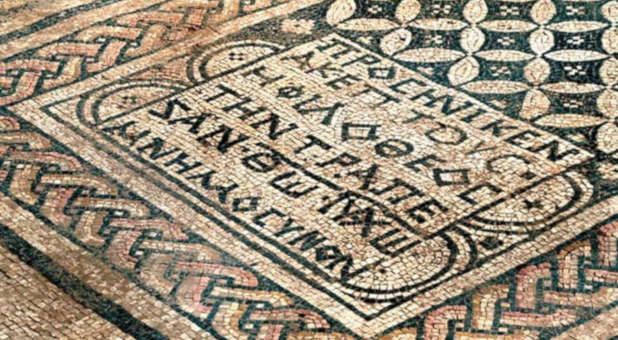Should the Ancient Meggido Mosaic Near Armageddon Remain in Israel?
The ancient Megiddo Mosaic, discovered in northern Israel, is the center of a debate regarding its potential loan to the Museum of the Bible in Washington, USA.
This controversy underscores the deepening ties between Israel and evangelical Christians in the United States, whom Israel has come to count on for political support, tourism dollars and other benefits.
From a Christian perspective, the mosaic’s historical and spiritual significance, combined with concerns about preserving its authenticity and context, warrant its continued presence in Israel.
The mosaic bears Greek inscriptions, among them is an offering “To God Jesus Christ.”
The Megiddo Mosaic’s location near the historical site of Tel Megiddo holds special meaning for Christians. Referred to as Armageddon in the book of Revelation, this region is prophesied to be the backdrop for the long-awaited ultimate battle between good and evil during the Second Coming of Christ.
Officials at the Israel Antiquities Authority says it will decide about the move in the coming weeks, following consultations with an advisory body.
“There’s an entire process that academics and archaeologists are involved with,” said IAA director Eli Eskozido.
The Megiddo Mosaic comes from what is believed to be the world’s earliest Christian prayer hall that was located in a Roman-era village in northern Israel. It was discovered by Israeli archaeologists in 2005 during a salvage excavation conducted as part of the planned expansion of an Israeli prison.
Officials at the Israel Antiquities Authority said that moving the mosaic from its original location was the best way to protect it from upcoming construction at the prison. Officials from the Museum of the Bible say the decision on whether or not to move it will be solely in the hands of the IAA, but that the Museum of the Bible would certainly be pleased with its presence.
“The museum of course would welcome the opportunity to educate our thousands of visitors on important pieces of history such as this mosaic,” Jeffrey Kloha, the Museum of the Bible’s chief curatorial officer, told the Associated Press in an email.
Some critics say that moving the Megiddo Mosaic would be a mistake before an academic study on it is complete.
“It is seriously premature to move that mosaic,” says Matthew Adams, director of the Center for the Mediterranean World, an non-profit archaeological research institute who is involved in digs at Tel Megiddo and the abutting Roman legionary camp of Legio.
The mosaic’s significance extends beyond its religious implications. Archaeological artifacts, like the Megiddo Mosaic, are best understood and appreciated within their original contexts. Uprooting such artifacts from their place of discovery can lead to a loss of crucial historical insights.
Strengthening Faith and Pilgrimage
For many Christians, visiting the Holy Land is a significant spiritual pilgrimage, and the Megiddo Mosaic’s location adds a layer of significance to this journey. It offers believers the opportunity to connect with the historical roots of their faith.
Pilgrims visiting Tel Megiddo are able to stand where early Christians may have prayed, reinforcing their spiritual connection to biblical history.
As an archaeological treasure and a symbol of Christian history, the Megiddo Mosaic’s significance makes a compelling case for its preservation in Israel. As Jews in Israel and evangelical Christians maintain their important relationship, the mosaic’s presence in Israel will continue to serve as a tangible link to the past, providing insight into the early days of Christianity and the prophesied events of Armageddon. {eoa}
Join Charisma Magazine Online to follow everything the Holy Spirit is doing around the world!
Shawn A. Akers is the online editor at Charisma Media.














































